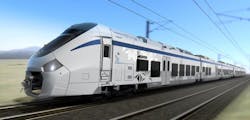Alstom and SNTF Reveal the Design of Alstom’s New "Main Line" Train for Algeria
Alstom and the National Rail Transportation Company of Algeria (SNTF) have unveiled the design of the new Coradia Polyvalent "main line" train destined to run in Algeria during the 4th edition of the International Transport, Logistics & Mobility Exhibition to be held in Algiers.
In July 2015, SNTF ordered 17 Coradia Polyvalent trains from Alstom as part of a project to modernize and extend its network. The trains’ entry into commercial service, notably connecting Algiers to the cities of Oran, Annaba, Constantine and Bechar, is scheduled from January 2018.
"The project is underway and is progressing extremely well — at full speed." said Yacine Benjaballah, managing director of SNTF. "We are very satisfied with the progress made and the results obtained. This train will become a national asset, satisfying the needs of our passengers who will be proud to use it."
"The design of Coradia Polyvalent for SNTF was developed by Alstom's Design&Styling department in close collaboration with the SNTF teams. Through the design, the teams have attempted to evoke the modernization, movement and beauty of Algeria’s landscapes with the shared goal of offering passengers a unique and comfortable travelling experience," said Henri Bussery, general manager of Alstom Algeria.
The external livery of the train reflects the various landscapes traveled through (city, countryside, coasts, mountain), through its subtly reflective coating. The interior of the train is spacious and bright. The train is fully air-conditioned and has a dining area and comfortable seating.
Coradia Polyvalent for SNTF benefits from the latest technological innovations. It is a bimodal train (diesel or 25kV electric) capable of running at speeds of 160 km/h. With a total length of 110 meters, the train has six cars and can accommodate 254 passengers. It is adapted to the climatic and environmental conditions of the country with a highly efficient air conditioning system. Its low floor facilitates access and movement on board, in particular for people with reduced mobility (PMR). The architecture of the train and its powerful engine eliminates noises and vibrations, offering unrivaled comfort of travel.
The 17 trains are being manufactured at Alstom’s site in Reichshoffen, France. Four other Alstom sites in France are involved in the development of the trains: Le Creusot for the bogies, Ornans for the motors, Tarbes for the traction system and Villeurbanne for on-board electronic and passenger information systems.
